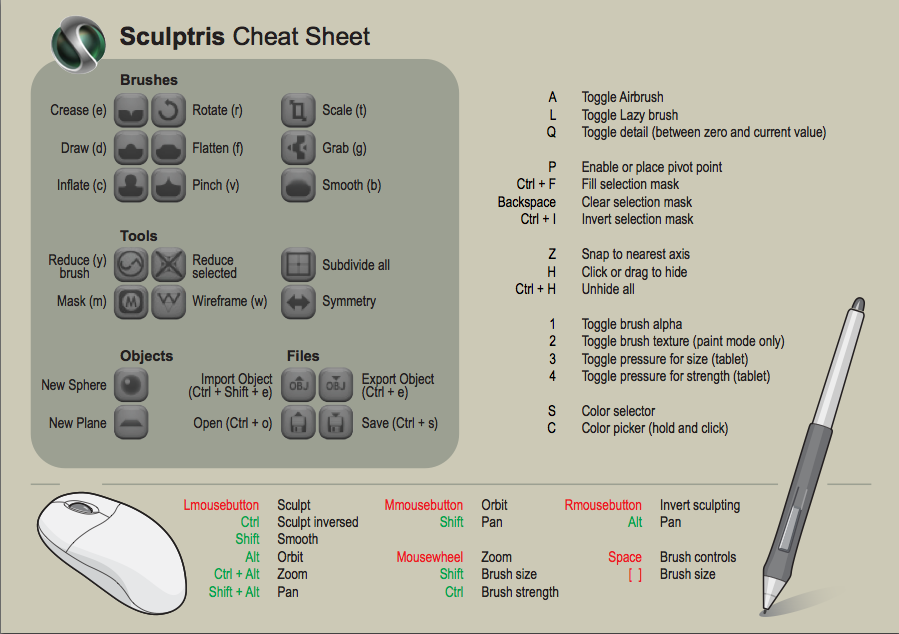
Finding none, I imported it into Makerware and set up my 3D print job. stl before importing it to meshlab to check for holes in the mesh. obj export in Rhino and converted it to an.

He has some fins and spikes and flat parts (to test how these various features would print), but is also fairly simple. I started modeling my dragon, but after a while I realized that it would be smart to do something simple in Sculptris to make sure that it was possible to convert to the correct file format and 3D print. work with massive brush to effect whole mask area Adds detail to wireframe so doesn't stretch too thin alt with brush to do inverse (alt+e makes ridges instead of creases) E for crease brush- separates forms a bit reduce mode to get rid of excess polygons, which will smooth out pinches Concept art on page same size as screen so doesn't distort
Sculptris shortcuts sheet how to#
Some tips up front so you don't make the same time-consuming mistakes that I do: check enable under brush for tools when you want to move the clay more dramatically (I spent a few hours trying to figure out how to build up the wings before checking this box and solving my problem within minutes), rotate the object regularly to check that you are modeling what you want to from all angles (I got a lot of strange skewing initially), and a graphics tablet is much more intuitive than a mouse. I enjoy sculpting in clay, and found this interface fun at first, but I ran into some problems with the settings of tools that made my life very difficult. Sculptris's commands are made to resemble sculpting in clay.
Sculptris shortcuts sheet free#
After a lot of browsing I settled on Sculptris, a free version of Z-Brush that is user-friendly. I started by looking at various 3D modeling software, trying to find one that was both good for modeling organic forms and intuitive to use.

I decided to stay consistent to the theme that I appear to be settling around in this course: dragons. This was my first time ever 3D printing, so I wasn't entirely sure where to start. I was just wondering if someone that sculpts mostly with keyboard shortcuts would have some info to share with us.The assignment for this week was to 3D print something that wouldn't be possible (or at least would be very difficult) to make using a different CNC machine from this course. I stumbled upon the keyboard shortcut by "accident" and found it very practical as it is still the only way I've found to do it.Īnd there happens to be another "!!! keyboard for the turntable animation however I have no idea what key combination it may be.not really important but it's there somewhere!Īlso, In a video I believe to have seen a guy cycling through materials with a shortcut and without going through the material screen overlay.this could be useful and time-saving when testing out various Macrea's on a sculpt.don't know how it's done though? I had seen it used in some of the video tutorials but didn't know where to find it on the CHEATSHEET as I am unable to locate the option in the user interface. My finding to share would be Num-Pad "9" hides the model's mirrored half. I'm talking about the Easter egg/hidden keyboard shortcuts that you may have discovered that are "not" on the CHEATSHEET and that are "possibly" not in the user interface.


 0 kommentar(er)
0 kommentar(er)
